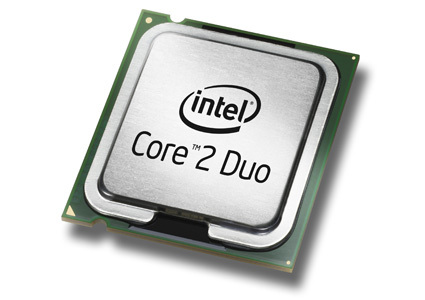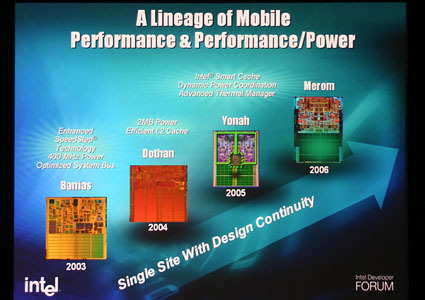Core 2 Duo Processor In Detail
Intel is back: After debuting in the Xeon 5100 ("Woodcrest") processor about a month ago, "Core" will power the firm's new Core 2 Duo mobile and desktop processors.
Intel is back : After debuting in the Xeon 5100 ("Woodcrest") processor about a month ago, "Core" will power the firm’s new Core 2 Duo mobile and desktop processors.
The "basic" version of the processor is called Core 2 Duo and is available as the E6000 series (formerly code-named "Conroe") for desktop computers and as T5000/T7000 series (formerly code-named "Merom") for notebooks. The "E" indicates a power consumptio
The "basic" version of the processor is called Core 2 Duo and is available as the E6000 series (formerly code-named "Conroe") for desktop computers and as T5000/T7000 series (formerly code-named "Merom") for notebooks. The "E" indicates a power consumptio
The flagship Core 2 Duo is the $1000 Core 2 Extreme X6800, the fastest desktop processor money can buy these days. The CPU is clocked at 2.93 GHz. Intel already confirmed that it will follow up with a faster version later this year. Some PC manufacturers,
The flagship Core 2 Duo is the $1000 Core 2 Extreme X6800, the fastest desktop processor money can buy these days. The CPU is clocked at 2.93 GHz. Intel already confirmed that it will follow up with a faster version later this year. Some PC manufacturers,
Desktop Core 2 Duo processors will be available with the currently available 975X and 946 chipset, but are expected to mainly appear in combination with the 963 and 965 series (G, P and Q versions) of chipsets.
Desktop Core 2 Duo processors will be available with the currently available 975X and 946 chipset, but are expected to mainly appear in combination with the 963 and 965 series (G, P and Q versions) of chipsets.
Actual picture of a Conroe die: The chip has a total of 291 million transistors. Note on the right side the two symmetrically aligned cores and the shared L2 cache on the left (4MB for Core 2 Duo E6000 and T7000; 2 MB for the T5000 and the upcoming E4000.
Actual picture of a Conroe die : The chip has a total of 291 million transistors. Note on the right side the two symmetrically aligned cores and the shared L2 cache on the left (4MB for Core 2 Duo E6000 and T7000 ; 2 MB for the T5000 and the upcoming E4000.
The complete "Core" line-up: Woodcrest (Xeon 5100) as well as the two new Core 2 Duos Merom and Conroe. Merom provides the technology foundation for Conroe and Woodcrest.
The complete "Core" line-up : Woodcrest (Xeon 5100) as well as the two new Core 2 Duos Merom and Conroe. Merom provides the technology foundation for Conroe and Woodcrest.
Intel will be ramping Core as fast as it can. 15% of its desktop processors shipped in Q3 will be Conroes. Note that the share will be almost 40% in Q1 of next year.
Intel will be ramping Core as fast as it can. 15% of its desktop processors shipped in Q3 will be Conroes. Note that the share will be almost 40% in Q1 of next year.
Get Tom's Hardware's best news and in-depth reviews, straight to your inbox.
A similar picture for desktop chipsets: The desktop-focused 965 series will ramp parallel to Conroe.
A similar picture for desktop chipsets : The desktop-focused 965 series will ramp parallel to Conroe.
The road to Core 2 Duo: The idea and foundation for Merom can be tracked back to "Banias," the first Pentium M processor. Dothan was introduced as a 90 nm version of Banias, the 65 nm Yonah (Core Duo) was introduced in January (with wide availability begi
The road to Core 2 Duo : The idea and foundation for Merom can be tracked back to "Banias," the first Pentium M processor. Dothan was introduced as a 90 nm version of Banias, the 65 nm Yonah (Core Duo) was introduced in January (with wide availability begi
Another distant ancestor of Merom: The Pentium III was Intel's first processor that came with "Speedstep" technology, which automatically decreased the clock speed of the processor when a notebook was running in battery mode. Interestingly, Speedstep was
Another distant ancestor of Merom : The Pentium III was Intel’s first processor that came with "Speedstep" technology, which automatically decreased the clock speed of the processor when a notebook was running in battery mode. Interestingly, Speedstep was
Merom's predecessor: Core Duo ("Yonah") processors on a 300 mm wafer.
Merom’s predecessor : Core Duo ("Yonah") processors on a 300 mm wafer.
Tom's Hardware is the leading destination for hardcore computer enthusiasts. We cover everything from processors to 3D printers, single-board computers, SSDs and high-end gaming rigs, empowering readers to make the most of the tech they love, keep up on the latest developments and buy the right gear. Our staff has more than 100 years of combined experience covering news, solving tech problems and reviewing components and systems.











